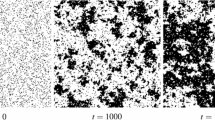Abstract
A basic property of one-dimensional surjective cellular automata (CA) is that any preimage of a spatially periodic configuration (SPC) is spatially periodic as well. This paper investigates the relationship between the periods of SPC and the periods of their preimages for various classes of CA. When the CA is only surjective and y is a SPC of least period p, the least periods of all preimages of y are multiples of p. By leveraging on the De Bruijn graph representation of CA, we devise a general algorithm to compute the least periods appearing in the preimages of a SPC, along with their corresponding multiplicities (i.e. how many preimages have a particular least period). Next, we consider the case of linear and bipermutive cellular automata (LBCA) defined over a finite field as state alphabet. In particular, we show an equivalence between preimages of LBCA and concatenated linear recurring sequences (LRS) that allows us to give a complete characterization of their periods. Finally, we generalize these results to LBCA defined over a finite ring as alphabet.







Similar content being viewed by others
References
Berlekamp ER (1967) Factoring polynomials over finite fields. Bell Syst Tech J 46(8):1853–1859
Cattaneo G, Finelli M, Margara L (2000) Investigating topological Chaos by elementary cellular automata dynamics. Theor Comput Sci 244(1–2):219–241
Cattaneo G, Dennunzio A, Margara L (2004) Solution of some conjectures about topological properties of linear cellular automata. Theor Comput Sci 325(2):249–271
Chassé G (1990) Some remarks on a LFSR ”disturbed” by other sequences. In: EUROCODE ’90, international symposium on coding theory and applications, Udine, Nov 5–9, 1990, Proceedings, pp 215–221
Dennunzio A, Formenti E, Weiss M (2014) Multidimensional cellular automata: closing property, quasi-expansivity, and (un) decidability issues. Theor Comput Sci 516:40–59
Durand B (1999) Global properties of cellular automata. In: Cellular automata and complex systems, Springer, pp 1–22
Formenti E, Papazian C, Scribot PA (2014) Additive flowers. In: CIBB 2014
Hedlund GA (1969) Endomorphisms and automorphisms of the shift dynamical systems. Math Syst Theory 3(4):320–375
Hell M, Johansson T, Maximov A, Meier W (2008) The grain family of stream ciphers. In: New stream cipher designs—the eSTREAM finalists, pp 179–190
Lidl R, Niederreiter H (1994) Introduction to finite fields and their applications. Cambridge University Press, Cambridge
Mariot L, Leporati A (2014) Sharing secrets by computing preimages of bipermutive cellular automata. In: Cellular automata—11th international conference on cellular automata for Research and industry, ACRI 2014, Krakow, Sept 22–25, 2014. Proceedings, pp 417–426
Mariot L, Leporati A (2015) On the periods of spatially periodic preimages in linear bipermutive cellular automata. In: Cellular automata and discrete complex systems—21st IFIP WG 1.5 international workshop, AUTOMATA 2015, Turku, June 8–10, 2015. Proceedings, pp 181–195
Massey JL (1969) Shift-register synthesis and BCH decoding. IEEE Trans Inf Theory 15(1):122–127
McEliece R (2002) The theory of information and coding. Cambridge University Press, Cambridge
Perrin D, Pin JÉ (2004) Infinite words: automata, semigroups, logic and games, vol 141. Academic, Cambridge
Sutner K (1991) De Bruijn graphs and linear cellular automata. Complex Syst 5(1):19–30
Sutner K (2010) Cellular automata, decidability and phasespace. Fundam Inform 104(1–2):141–160
Wagstaff S (2002) Cunningham project. http://homes.cerias.purdue.edu/~ssw/cun/index.html. Accessed 22 July 2016
Acknowledgements
The authors wish to thank Ilkka Törma for suggesting that Lemma 4 holds in the general surjective case, and Marco Previtali for insightful comments about the computational complexity of the u-closure graph building procedure. Further, the authors are grateful to the anonymous reviewers for their helpful comments on how to improve the paper.
Author information
Authors and Affiliations
Corresponding author
Rights and permissions
About this article
Cite this article
Mariot, L., Leporati, A., Dennunzio, A. et al. Computing the periods of preimages in surjective cellular automata. Nat Comput 16, 367–381 (2017). https://doi.org/10.1007/s11047-016-9586-x
Published:
Issue Date:
DOI: https://doi.org/10.1007/s11047-016-9586-x
Keywords
- Cellular automata
- Surjectivity
- De Bruijn graph
- Bipermutivity
- Linear recurring sequences
- Linear feedback shift registers




